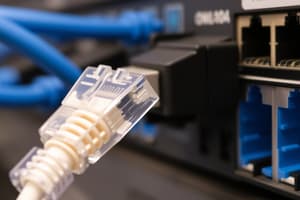Podcast
Questions and Answers
What is the primary use of Ethernet network cables?
What is the primary use of Ethernet network cables?
- Connecting devices to the internet (correct)
- Connecting devices to scanners
- Connecting devices to speakers
- Connecting devices to printers
What is the purpose of the foil shield in shielded twisted pair cables?
What is the purpose of the foil shield in shielded twisted pair cables?
- To reduce the cost of the cable
- To increase the speed of data transmission
- To provide extra protection against electromagnetic interference (correct)
- To prevent physical damage to the cable
What type of cable is used to connect two similar devices directly?
What type of cable is used to connect two similar devices directly?
- RJ45 cable
- Crossover cable (correct)
- Straight-through cable
- Patch cable
What is the purpose of twisting the wires together in unshielded twisted pair cables?
What is the purpose of twisting the wires together in unshielded twisted pair cables?
What are the two main wiring standards for Ethernet cables?
What are the two main wiring standards for Ethernet cables?
What is the order of the wires in the 568A standard?
What is the order of the wires in the 568A standard?
Flashcards
Ethernet Cable Use
Ethernet Cable Use
Connects devices to the internet, enabling network communication.
Foil Shield Purpose
Foil Shield Purpose
Provides extra protection against electromagnetic interference (EMI).
Crossover Cable Use
Crossover Cable Use
Connects two similar devices, like PC-to-PC, directly.
Twisted Wires Purpose
Twisted Wires Purpose
Signup and view all the flashcards
Ethernet Wiring Standards
Ethernet Wiring Standards
Signup and view all the flashcards
568A Wiring Order
568A Wiring Order
Signup and view all the flashcards
Study Notes
- Ethernet network cables are used in local networks, connecting devices to routers, modems, or switches, enabling internet access.
- There are two types of Ethernet cables: unshielded twisted pair (UTP) and shielded twisted pair (STP).
- Unshielded twisted pair cables have four colored pairs of wires twisted together to prevent electromagnetic interference and crosstalk.
- Shielded twisted pair cables have a foil shield that provides extra protection against electromagnetic interference and are typically used in industrial settings.
- To make your own Ethernet cables, you need to buy a large roll of cable with twisted pairs, strip the outer casing, and attach RJ45 connectors to each end.
- There are two main types of Ethernet cables: straight-through cables and crossover cables.
- Straight-through cables, also known as patch cables, are used to connect devices to hubs, switches, routers, or modems.
- Crossover cables are used to connect two similar devices directly, such as two computers, without the need for a hub or switch.
- There are two wiring standards for Ethernet cables: 568A and 568B, which differ in the color coding of the wires.
- The 568A standard wires the cable in the following order: white-green, green, white-orange, blue, white-blue, orange, white-brown, and brown.
- The 568B standard wires the cable in the following order: white-orange, orange, white-green, blue, white-blue, green, white-brown, and brown.
- Category-rated cables (CAT) are classified based on their maximum speed and density of twists per inch, with CAT 3 being the slowest and CAT 7 being the fastest.
- The speed of CAT-rated cables ranges from 10 Mbps for CAT 3 to 10 Gbps for CAT 6a and CAT 7.
- Most networks today use at least CAT 5e, which can handle gigabit speeds.
- CAT 8 is the latest and fastest category of Ethernet cables, with a speed of 40 Gbps over a distance of 30 meters.
Studying That Suits You
Use AI to generate personalized quizzes and flashcards to suit your learning preferences.




